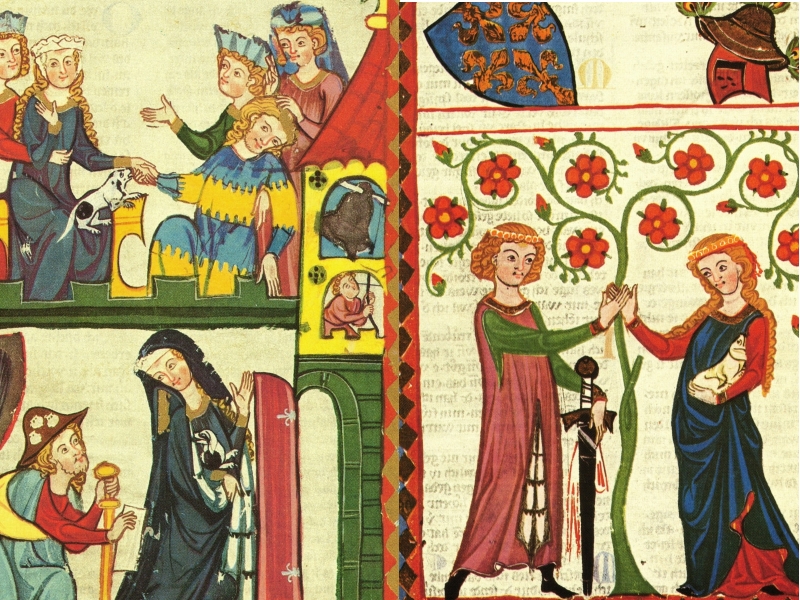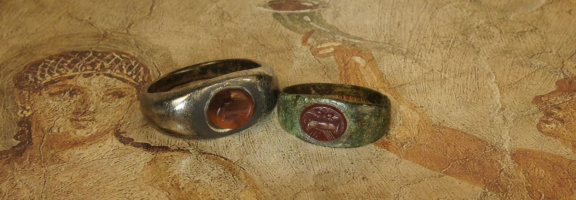In the late Middle Ages, goldsmiths and silversmiths began to take an increasing interest in the clasped right hands. The Fede symbol became an image for courtly love, the Minne: the consuming, unfulfilled love of a courtly knight for a mostly married, higher-ranking woman. The mani in fede (written in Italian from now on) was particularly popular at the court of Eleanor of Aquitaine in the 12th century. The Duchess was one of the most influential women of the Middle Ages, first Queen of France by marriage, then Queen of England. With her aesthetics and taste, she not only shaped her two courts and their countries, but also the Holy Roman Empire somewhat later.
As the German poetry of the Middle Ages shows, the aristocratic German minstrels with their love poetry at the courts of the Staufer were in no way inferior to the French troubadours and trouvères (Fig. 04).

Fig. 04: Excerpts from the Manessian song manuscript, around 1300. Author's picture by Johannes Hadlaub and Herr Berngers von Horheim. The mani in fede were very popular at the French, English and Roman-German courts. Due to its loyal nature, the dog became a symbol of fidelity and "loyal".
With the Fede ring, not only the high nobility expressed their passionate love and affection, but alos the less wealthy did not want to do without this token of love. Incidentally, the noblewomen were just as happy to give rings to the noblemen as vice versa. Walther von der Vogelweide addressed the love between a minstrel and a young maid who was below his rank in the medieval estate system: "You are beautiful and have enough: what can they tell me about that? Whatever they say, I love you, and take your little ring of glass for a queen's gold." (Herzeliebes vrouwelin, L 49, 25.) Apparently the knight's friends criticized his "inappropriate" love. But the beauty of the young woman was worth enough to him, and he valued her glass ring, probably a bronze ring with a glass stone for the ring head, as highly as a queen's gold ring. While in the Holy Roman Empire jewellery was reserved for church dignitaries and the nobility until around the middle of the 14th century, i.e. it was mainly made for spiritual and secular power, the bourgeoisie gained strength around 1350. Prosperous professions such as merchants, cloth merchants, money changers, goldsmiths and salt workers began to adorn themselves. So that the bourgeois social climbers could not put themselves on an equal footing with the nobility, dress codes and laws on the wearing of jewellery were enacted in the late Middle Ages, which clearly differentiated the individual classes from one another.
As with the Romans, the clasped right hands were not only a symbol of friendship, respect and love in the Middle Ages, but also they were the sign of loyalty for an alliance that usually led to a marriage. The Latin expression mani in fide was used by the ancient Romans to symbolize the promise of marriage, in medieval England the English term handfast appeared for it. The knight Thomas Malory wrote in 1469 in his Arthurian epic, which has shaped our reception of Arthur to this day: "And anon he made them handfast, and wedded them." (Le Morthe Darthur, X, 37.)
Handfast, in German "handfest", in Middle High German "hantveste", in our context probably means "to fix, to make tangible, to make visible". In the Arthurian legend, Alisander manifested the love of a nobleman and a noblewoman and made them marry each other.
In terms of design, the interlocking right hands usually formed the bezel, as in the ancient Roman design, i.e. they are the decorative element on top of the ring band - and that has remained so to this day (Fig. 05). Occasionally, the mani in fede were also placed at the base of the hoop in the Middle Ages, with the ring head being decorated with a cabochon-cut gemstone or precious stone.

Fig. 05: Collection TN: Middle Ages, 13th-15th centuries, bronze formerly gilded. The bezel consists of the two clasped right hands. This ancient Roman design was revived at the latest in the 12th century as a symbol of friendship and love. The cuffs are decorated with simple engravings. The less expensive gilt bronze used here suggests that the motif was readily adopted by those of more modest means.
Recent excavations show the diversity of the late medieval design language: the two hands, for example, are gloved or ringed. In addition, inscriptions in blackened letters (mostly in Lombard majuscule) testified not only to love, but also to the religious Christian faith. These love mottos were called posies, derived from the French poésie, poetry, versification, minstrelsy. In the 15th century, these posies were mainly in French, which was the universal language of love. It can be assumed that the wearer of a posy ring could read, write and understand French. To this day, we still refer to a motto ring as a posy ring. The Burgundian court, with its exquisite goldsmith's art, became a model for the whole of Europe. Of great importance was the innovation of body enamel in Limoges. This invention enabled fine, pictorial depictions applied with a brush, or the painting of curved surfaces and cast or embossed ornaments such as the mani in fede.
The earliest gimmel rings known to me also date back to the Middle Ages. The term derives from the Latin gemellus, twin. With the gimmel ring, the ring rail is divided into several narrow hoops, which can be moved individually, but are inseparably connected and only together form the whole ring. Only when the hoops are closed do the two right hands clasp. The gimmel ring is a beautiful symbol of two lovers, each free and independent and yet only jointly making a whole, walking side by side through life. The gimmel ring was already very popular at the end of the Middle Ages. Unfortunately, these handcrafted beauties of the late Middle Ages are rarely found in the jewellery trade (Fig. 06).

Fig. 06: Collection TN: Middle Ages, 13th-15th centuries, silver formerly gilded. Gimmel ring. Here the double hoop is intertwined with an intricate sophisticated swivel joint, showing the creativity of late medieval goldsmiths. In addition, the ring hoops feature simple decorative engravings and the hands are adorned with cuffs in the shape of tulips, the most famous meaning of which is perfect, deep love.
×
